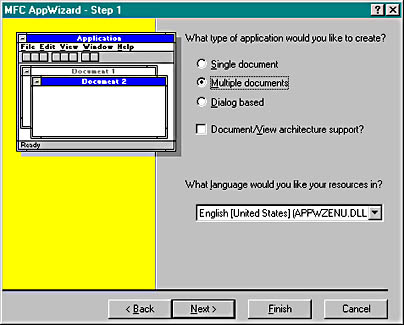The EX23C Example—An MDI Application
Now let's create an MDI application that doesn't use the document-view
architecture.
- Run AppWizard to produce \vcpp32\ex23c\ex23c.
Select the Multiple Documents option in the AppWizard Step 1 dialog and uncheck the Document/View Architecture Support? option, as shown here.

- Add code to paint in the dialog.
Add the following boldface code to the CChildView::OnPaint function in the ChildView.cpp source code file:
void CChildView::OnPaint()
{
CPaintDC dc(this); // device context for painting
dc.TextOut(0, 0, "Hello, world!");
// Do not call CWnd::OnPaint() for painting messages
}
- Compile and run. You now have a complete MDI application without dependencies on the document-view architecture.
As in EX23B, this example automatically creates a CChildView class. The main difference between EX23B and EX23C is the fact that in EX23C the CChildView class is created in the
CChildFrame::OnCreate function instead of in the CMainFrame class.
In this chapter you've learned how to create three kinds of applications that do not depend on the document-view architecture. Examining how these applications are generated is also a great way to learn how MFC works. We recommend that you compare the generated results to similar applications with
document-view architecture support to get a complete picture of how the document-view classes work with the rest of MFC.
